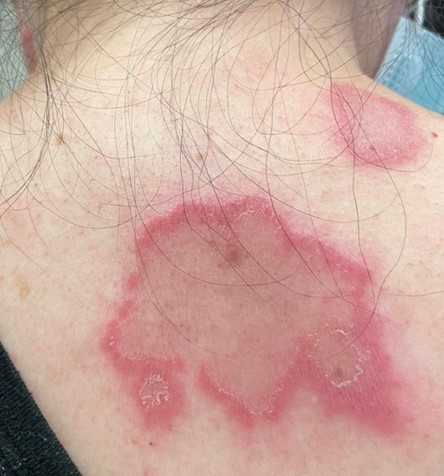Research & Publications > The Hong Kong Practitioner > Clinical Quiz

Clinical Quiz (Please login 'Member Area' for online submission of latest issue)
Clinical Quiz September 2022
A middle-aged lady presented with gradual onset of an annular rash over
body
Ngan-ming Lau
|
Readers are invited to participate in the Clinical Quiz*. Simply answer the question, fill in the reply slip and return it to the College by 17 November 2022. Each reader is allowed to submit one entry only. The name of the winner and the answer will be published in the December 2022 issue.
*Note: There would be no prize award for this issue while sponsorship for Clinical Quiz has been ended in September 2020 issue. The answer of the Clinical Quiz for this issue will be announced in the next issue. Thank you for your support.
|
Clinical history:
A 53-year-old lady presented with gradually progressing non-itchy rash
over upper chest and back for 3 months. There is no loss of sensation. She
denied any joint pain, oral ulcer or hair loss. She has no history of drug
allergy. There was no medication use prior to onset of rash.
What is the diagnosis?
| A. | Erythema annulare centrifugum |
| B. | Subacute cutaneous lupus erythematosus |
| C. | Tinea corporis |
| D. | Granuloma annulare |
Answer:
B. Subacute cutaneous lupus erythematosus
Subacute cutaneous lupus erythematosus (SCLE) is a subtype of cutaneous lupus erythematosus. It is most often diagnosed in middle-aged women but patients can be of any age or sex. SCLE presents as erythematous papules that evolve into psoriasiform or annular plaques. The annular plaques could coalesce to form polycyclic patterns. Overlying scale could be variable. The rash is typically distributed on the sun-exposed areas including the upper trunk, shoulders, forearms, neck, but the face is often spared. SCLE can be associated with systemic lupus erythematosus.
Approximately 20-40% of cases of SCLE are druginduced. The drugs commonly associated with SCLE are diuretics, angiotensin-converting enzyme inhibitors, calcium channel blockers, terbinafine, proton pump inhibitors and others.
SCLE can be diagnosed clinically, supported by skin biopsy and blood tests. Histologically, SCLE shows basal vacuolar changes and mucin deposition in the dermis. Compared with discoid lupus erythematosus, SCLE has less hyperkeratosis and follicular plugging. Around 60% of patients with SCLE has positive antinuclear antibody (ANA). Patients with SCLE have higher prevalence and titers of anti-Ro/SSA antibody than those with chronic cutaneous lupus erythematosus.
Sun protection is crucial in the treatment for subacute cutaneous lupus erythematosus. Topical therapy includes topical steroids and topical calcineurin inhibitors. Oral treatment includes antimalarials (e.g. hydroxychloroquine), oral steroid, methotrexate, mycophenolate, oral retinoid and other agents.
Erythema annulare centrifugum
Erythema annulare centrifugum (EAC) presents as chronic arcuate or annular, erythematous patches or plaques, with a characteristic trailing scale along the inner portion of the advancing edge of lesions. The rash may be itchy. EAC typically affects the thighs, buttocks, and upper arms. The pathogenesis of EAC is unclear.
Histologically, superficial types of EAC have a dense perivascular lymphocytic infiltrate surrounding superficial vessels, which resembles a ‘coat-sleeve’ appearance. Literature on treatments for EAC are limited. For patients with a suspected trigger, treatment of an underlying disease can lead to resolution of EAC. For patients without an identifiable trigger, treatment is focused on improvement of symptoms, which includs topical and intralesional corticosteroids and antipruritic agents.
Tinea corporis
Tinea corporis is a superficial fungal infection of the skin other than the hands, feet, scalp, face, groin, and nails. Trichophyton rubrum is the most common cause of tinea corporis. It is commonly called ‘ringworm’ as it presents with characteristic annular (ring-shaped) scaling patch or plaque. With time, multiple lesions can develop. Itch is common.
Tinea can be diagnosed based on the physical examination. For some cases, skin scrapings for microscopy and fungal culture are indicated. Treatment with topical antifungals is usually helpful. In resistant cases, systemic antifungals maybe necessary.
Granuloma annulare
Granuloma annulare (GA) can present with a variety of clinical findings. Clinical subtypes include localised GA, generalised GA, subcutaneous GA and perforating GA.
The cause of GA is unknown. It has been reported to be associated with systemic conditions including diabetes mellitus, hyperlipidaemia, and rarely with malignancy, HIV infection and thyroid disease.
The localised form is the most common type of granuloma annulare, and specifically in children and young adults. It presents as an asymptomatic, erythematous or skin-colored, annular or arciform plaque. Discrete, 1 to 2 mm papules may be noted at the periphery of lesions. The most frequent sites of involvement are wrists, ankles, dorsal hands, and feet dorsum. It can be asymptomatic or mildly itchy.
Most cases of granuloma annulare are self-limiting, but some could be persistent. Treatment is not curative but may help individual lesions. Local therapy includes topical and intralesional corticosteroid, cryotherapy and topical calcineurin inhibitors. Systemic therapy may be considered in widespread GA.
The slide and the question were prepared by:
Dr Ngan-ming Lau, MBChB, MRCP(UK), FHKCP, FHKAM
Senior Medical
Officer,
Social
Hygiene Service, PHSB, CHP, DH
Back
